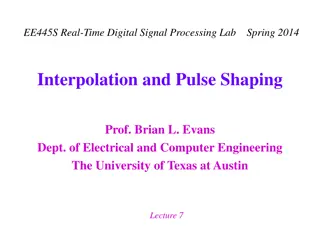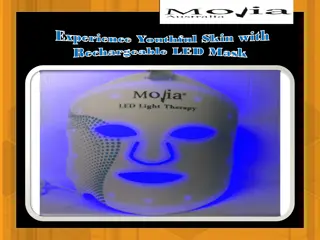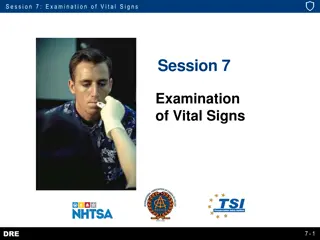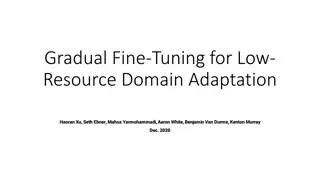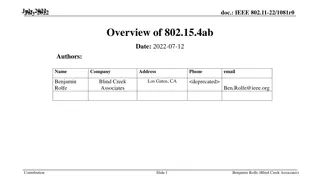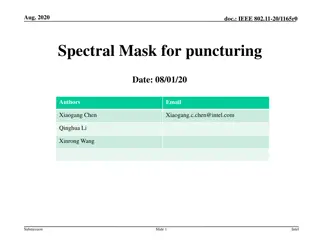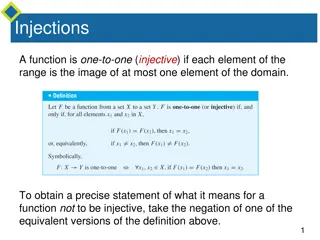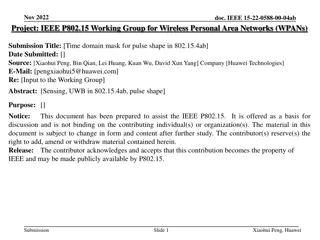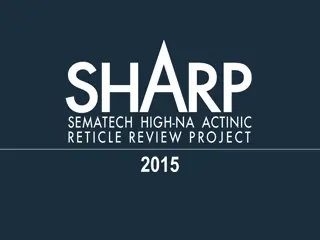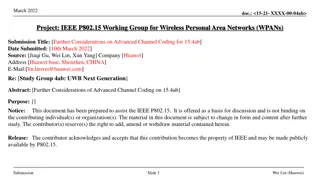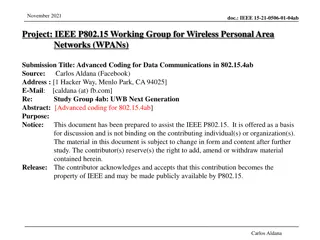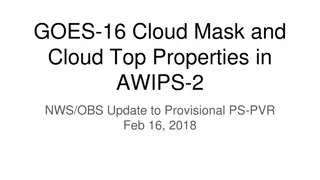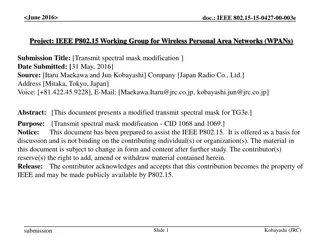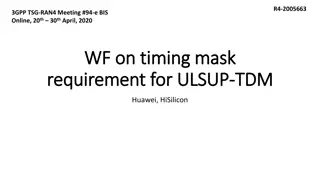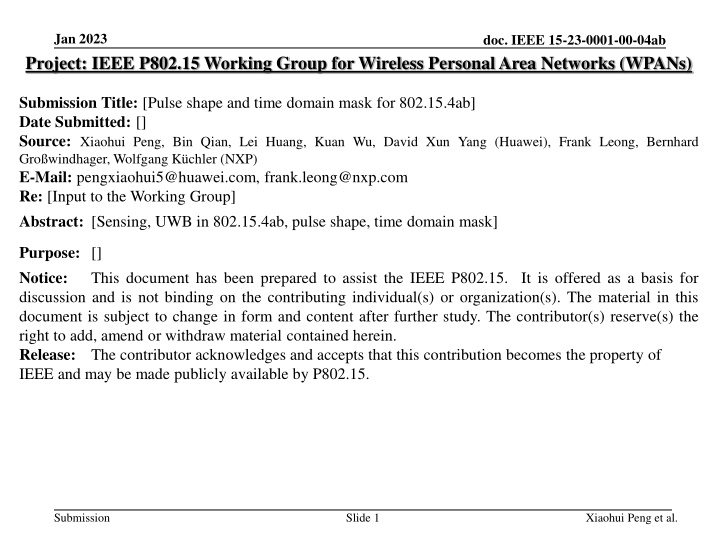
Advanced Wireless Personal Area Network (WPAN) Technology Development
Explore the latest advancements in wireless personal area networks (WPANs) focusing on pulse shape, time domain mask, and interference mitigation techniques for IEEE 802.15.4ab standard. The document discusses safeguards for data throughput, interference mitigation, coexistence improvements, and enhanced ranging capabilities. It also addresses pulse shape design, sensing capabilities, and support for various protocols, highlighting the evolution of WPAN technology towards high-throughput, low-latency applications.
Download Presentation

Please find below an Image/Link to download the presentation.
The content on the website is provided AS IS for your information and personal use only. It may not be sold, licensed, or shared on other websites without obtaining consent from the author. If you encounter any issues during the download, it is possible that the publisher has removed the file from their server.
You are allowed to download the files provided on this website for personal or commercial use, subject to the condition that they are used lawfully. All files are the property of their respective owners.
The content on the website is provided AS IS for your information and personal use only. It may not be sold, licensed, or shared on other websites without obtaining consent from the author.
E N D
Presentation Transcript
Jan 2023 doc. IEEE 15-23-0001-00-04ab Project: IEEE P802.15 Working Group for Wireless Personal Area Networks (WPANs) Submission Title: [Pulse shape and time domain mask for 802.15.4ab] Date Submitted: [] Source:Xiaohui Peng, Bin Qian, Lei Huang, Kuan Wu, David Xun Yang (Huawei), Frank Leong, Bernhard Gro windhager, Wolfgang K chler (NXP) E-Mail: pengxiaohui5@huawei.com, frank.leong@nxp.com Re: [Input to the Working Group] Abstract: [Sensing, UWB in 802.15.4ab, pulse shape, time domain mask] Purpose: [] Notice: discussion and is not binding on the contributing individual(s) or organization(s). The material in this document is subject to change in form and content after further study. The contributor(s) reserve(s) the right to add, amend or withdraw material contained herein. Release: The contributor acknowledges and accepts that this contribution becomes the property of IEEE and may be made publicly available by P802.15. This document has been prepared to assist the IEEE P802.15. It is offered as a basis for Submission Slide 1 Xiaohui Peng et al.
Jan 2023 doc. IEEE 15-23-0001-00-04ab PAR Objective Proposed Solution (how addressed) Safeguards so that the high throughput data use cases will not cause significant disruption to low duty-cycle ranging use cases Interference mitigation techniques to support higher density and higher traffic use cases Other coexistence improvement Backward compatibility with enhanced ranging capable devices (ERDEVs) Improved link budget and/or reduced air-time Unified pulse shape for ranging and sensing Additional channels and operating frequencies Improvements to accuracy / precision / reliability and interoperability for high-integrity ranging Reduced complexity and power consumption Hybrid operation with narrowband signaling to assist UWB Enhanced native discovery and connection setup mechanisms Sensing capabilities to support presence detection and environment mapping Low-power low-latency streaming Pulse shape design for sensing Higher data-rate streaming allowing at least 50 Mbit/s of throughput Support for peer-to-peer, peer-to-multi-peer, and station-to- infrastructure protocols Infrastructure synchronization mechanisms Submission Slide 2 Xiaohui Peng et al.
Jan 2023 doc. IEEE 15-23-0001-00-04ab Related Submissions 15-19-0443-01-004z text to address comment id r1-0820 (Michael McLaughin) 15-20-0084-00-004z pulse shaping considerations (Jochen Hammerschmidt) 15-20-0086-00-004z proposed pulse shape text changes for HRP UWB PHY (Michael McLaughin) 15-20-0089-01-004z pulse shape text changes for HRP UWB PHY (Michael McLaughin) 15-22-0040-04-04ab waveform design for UWB sensing (Xiaohui Peng) 15-22-0418-00-04ab sensing pulse shape consideration in 802.15.4ab (Xiaohui Peng) 15-22-0175-00-04ab sensing device (Dag T. Wisland ) 15-22-0061-00-04ab sensing continued (Frank Leong) 15-22-0305-00-04ab a summary of proposals and interests (Billy Verso) 15-22-0418-00-04ab-sensing-pulse-shape-consideration-in-802-15-4ab continued (Xiaohui Peng) 15-22-0588-00-04ab-time-domain-mask-for-pulse-shape-in-802-15-4ab (Xiaohui Peng) Submission Slide 3 Xiaohui Peng et al.
Jan 2023 doc. IEEE 15-23-0001-00-04ab Recap For sensing application, a pulse shape should be designed to minimize both precursors and postcursors. The pulse shape should be designed to support both ranging and sensing applications. The specific criteria for sensing pulse shape include range resolution, PSLR (Peak to sidelobe ratio) of the cross-correlation function, spectrum efficiency (or root mean square bandwidth). Pulse shape does not change in the middle of packet. Sensing pulse shape is used for entire packet in sensing applications. An ideal reference pulse shape should be defined. A more restrictive time-domain mask should be specified for the sensing pulse shape than ranging Submission Slide 4 Xiaohui Peng et al.
Jan 2023 doc. IEEE 15-23-0001-00-04ab Motivation We agree on a two-step definition for sensing pulse shape. An ideal reference pulse shape should be defined A restrictive sensing time-domain mask needs to be defined in 15.4ab. Reference pulse shape: The pulse shape should be designed to support both ranging and sensing applications, thus the pulse shape defined in 4ab shall be able to meet the mask defined in 4z. [Consensus]: Pulse shape does not change in the middle of packet. Sensing pulse shape is used for entire packet in sensing applications. Time-domain mask: Last meeting majority prefer to use a symmetric time-domain mask A symmetric time-domain mask shall be defined based on the mask in 15.4z. Submission Slide 5 Xiaohui Peng et al.
Jan 2023 doc. IEEE 15-23-0001-00-04ab Reference pulse shape For sensing, it is recommended to use a time-bounded Kaiser pulse shape as the reference A Kaiser pulse is shaped as a Kaiser-Bessel window also with no precursor and postcursor, which can be expressed as: 2 2? ? ?0?? 1 1 ? 0, ?(?) = , ? ?/2 ?0?? ? > ?/2 where I0 is the zeroth-order modified Bessel function of the first kind. L is the window duration, ? = ?? is a parameter determining the shape of the pulse. It is recommended to set L = 3 chips and ? = ?? =10 Submission Slide 6 Xiaohui Peng et al.
Jan 2023 doc. IEEE 15-23-0001-00-04ab Symmetric time-domain mask New mask Tw3=Tw1-2(Tw1-Tw2) 4z mask C:(Tw3 /2,y2) Tw2=2.25 B:(Tw1 /2,y2) C B Tw1=(1+2?) Tc Tc=2.5 A:(Tw1 /2,y1) A y=-y1 The new mask is centered at t = 0 A ,B and C are the points A, B and C mirrored in t = 0, respectively The new time-domain mask is determined by point A, B and C Point A is determined by Tw1 and y1 Point B is determined by Tw1 and y2 Point C is determined by Tw3 and y2 Like 15.4z, we recommend y1 = 0.015, y2 = 0.3 and Tw2 = 2.25 Tc is defined as the time duration between two points in the Kaiser pulse shape with y1=0.015 ? in Tw1 is a parameter used to define the margins, here we recommend ?= 0.05 Point A: (1.37,0.015) Point B: (1.37,0.3) Point C: (0.88,0.3) Submission Slide 7 Xiaohui Peng et al.
Jan 2023 doc. IEEE 15-23-0001-00-04ab Summary We recommend to use a time-bounded Kaiser pulse shape as the reference We recommend to use the symmetric time-domain mask shown in slides 7. Submission Slide 8 Xiaohui Peng et al.
Jan 2023 doc. IEEE 15-23-0001-00-04ab References 1. Amendment1: Enhanced ultra wideband (UWB) physical layers (PHYs) and associated ranging techniques IEEE standard for low-rate wireless networks UWB spectral mask and FFC part 15 limits 15-19-0443-01-004z text to address comment id r1-0820 (Michael McLaughin) 15-20-0084-00-004z pulse shaping considerations (Jochen Hammerschmidt) 15-20-0086-00-004z proposed pulse shape text changes for HRP UWB PHY (Michael McLaughin) 15-20-0089-01-004z pulse shape text changes for HRP UWB PHY (Michael McLaughin) 15-22-0040-04-04ab waveform design for UWB sensing (Xiaohui Peng) 15-22-0175-00-04ab sensing device (Dag T. Wisland ) 10. 15-22-0061-00-04ab sensing continued (Frank Leong) 11. 15-22-0305-00-04ab a summary of proposals and interests (Billy Verso) 12. 15-22-0418-00-04ab-sensing-pulse-shape-consideration-in-802-15-4ab continued (Xiaohui Peng) 13. 15-22-0588-00-04ab-time-domain-mask-for-pulse-shape-in-802-15-4ab (Xiaohui Peng) 2. 3. 4. 5. 6. 7. 8. 9. Submission Slide 9 Xiaohui Peng et al.

